Our design and marketing team recently completed an internal sales resources website. It provides case studies, one-pagers, and brochures. The materials can be downloaded and printed for trade shows, events, and presentations or emailed to customers and prospects. Sometimes one customer needs both. Anyone in the sales department can “order” a variety of TKO branded promotional products and have it delivered to their desk to give to customers. It allows our sales people to keep selling.
What Print Collateral Should you Share?
The answer will depend on your business and your target demographic. The question is what collateral print does your audience want? Do prospects visit your place of business? Do customers meet you at events? Does your sales staff visit clients?
- Brochures – Two or more pages sharing products, solutions, calls to action, and contact information.
- Catalogs – Entire product offerings by company or division.
- Direct mail – Letters and postcards to be mailed to clients.
- One pager – Similar to a brochure but single or double sided page.
- Case Studies – Built around testimonials based on problem-solution-outcome.
- eBooks – 25,000 words or more on business topics.
- Guides – Comprehensive “how to” format for solving consumer problems.
- Checklists – A to-do list for specific reoccurring activities.
E-Collateral
Every piece of print collateral listed above could and should be available electronically. If you have it in print—it should be online. However, there are collateral materials that can only be shared electronically and many that are shared best on the interwebs.
- Website – Your website is the first place most consumers find you. It’s your first chance for a positive impression. The answers to consumer’s questions should be readily available.
- Video – We are a visual culture. Consumers want and expect video as part of your collateral package.
- Infographics – Sharing information on an infographic can be accomplished in print or online, but it lends itself to E-Collateral.
- Images, slideshares, and presentations – From webinars to portfolios may be used to share specific stories to segmented audiences.
Both Should…
Print and E-Collateral shouldn’t be at odds with each other—they should complement each other. This is accomplished by integrating the two; using the strengths of both to share a unified brand delivered to consumers in the best package to meet their needs.
- Unified brand – Both electronic and print collateral should share logos, tag lines, colors, and typography.
- Solve problems/answer questions.
- Share the benefits with the consumer.
- Clarify the USP (Unique Sales Proposition)
- Make it easy to connect with your business.
There’s no cut and dried answer to your collateral needs. How much print collateral should you have? What electronic materials should you offer? These questions are best answered by asking your marketing and sales staff what they need for their customers. What does your target audience want in the way of collateral material? If you’d like to discuss and explore this topic, our expert staff at Marketing Solutions would be happy to share ideas with you—either in print or online.


Leave A Comment